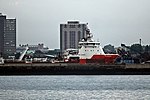Gladstone Dock railway station (Liverpool Overhead Railway)
Gladstone Dock was a station on the Liverpool Overhead Railway, between Alexandra Dock and Seaforth Sands. It was opened on 16 June 1930, the final station to open on the network. It was named after the adjacent Gladstone Dock, and was the only station on the network to be accessible directly from the dockside, with two steel bridges connecting the platforms, as it primarily served the passenger liners which frequently docked nearby. Only the northbound platform was directly accessible from the street.The station was opened at 6am on the first day of operation without a formal ceremony. It was originally only open on week days, but service was intended to be extended to be extended to weekends.The station was damaged during the Liverpool Blitz, requiring it to be rebuilt.The station closed, along with the rest of the line on 30 December 1956. No evidence of the station remains.
Excerpt from the Wikipedia article Gladstone Dock railway station (Liverpool Overhead Railway) (License: CC BY-SA 3.0, Authors).Gladstone Dock railway station (Liverpool Overhead Railway)
Geographical coordinates (GPS) Address Nearby Places Show on map
Geographical coordinates (GPS)
| Latitude | Longitude |
|---|---|
| N 53.4542 ° | E -3.0108 ° |
Address
L20 1BE , Seaforth
England, United Kingdom
Open on Google Maps






